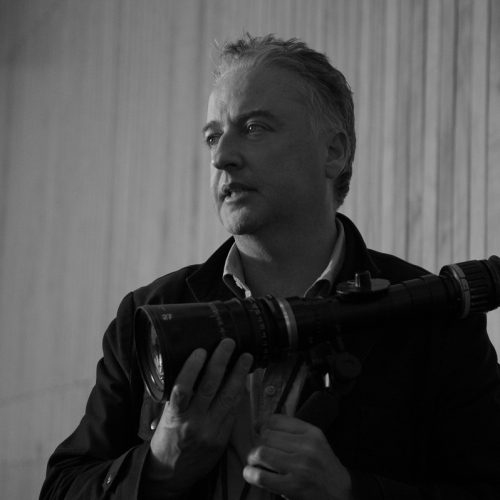Making a selection of the best British cinema over the past twenty years without including at least three films visually shaped by Seamus McGarvey would indeed be a daunting task. The magnificent sequences gracefully crafted through the spectacular dance of the camera in the screen adaptation of Leo Tolstoy’s classic “Anna Karenina”, the delicate movement of the camera building up the visual poetry of “Atonement” and “We Need to Talk about Kevin”, the vibrant mélange of sharp colours to achieve the stylistic nuances in “Nocturnal Animals” and the astonishing synchronization of the three different melancholic eras in “The Hours” leave a lasting impression on the minds of the viewers. All of this comes as a result of the brilliant cinematographic talent and skill of this year’s recipient of the Special Golden Camera 300 for Outstanding Contribution to World Cinematic Art – Seamus McGarvey.
Seamus McGarvey was born on June 29, 1967 in Armagh, a small town in Northern Ireland, close to the border with the Republic of Ireland. He started dealing with photography around the age of 12, while he was roaming his hometown, which at that time was not a very safe place to live due to the long-standing conflict between the Unionists and the Republicans in Northern Ireland. Yet, his photographs from that period of time do not document the violence, but Armagh’s scenic landscapes and peaceful locations.
After enrolling at the film school at the University of Westminster in London, he was fortunate enough to meet Jack Cardiff (cinematographer of some of the most famous films by Powell and Pressburger, John Huston and Alfred Hitchcock), who mentored him and inspired him towards an artistic approach to filmmaking.
The first films he started working on after his graduation in 1988 were short features and documentaries, including several ones with Joe Wright and Sam Taylor-Johnson, directors that he would later go on to collaborate with on feature films. He shot his first feature film, BUTTERFLY KISS, directed by Michael Winterbottom in 1994, which premiered at the Berlin Film Festival in 1995.
In 2004 he was awarded the Lumière Medal for contribution to the art of cinematography by the Royal Photographic Society, an award that had been presented to several other renowned cinematographers before him, including Jack Cardiff, Freddie Francis and Roger Deakins.
He has received two nominations for the Academy Award for Best Cinematography – for ATONEMENT (2007) directed by Joe Wright, and for ANNA KARENINA (2012) once again a collaboration with Joe Wright. He has won the Award of the British Society of Cinematographers (B.S.C.) twice – for ANNA KARENINA and NOCTURNAL ANIMALS (directed by Tom Ford), along with a nomination for ATONEMENT.
“Atonement” is, without any doubt, one of the most breath-taking works of recent British cinema, not only due to the extraordinary story and fantastic performances by the lead (and supporting) actors, but above all precisely because of the beautiful visualization achieved by the creative team led by Seamus McGarvey, which masterfully highlights the gracefulness and subtlety of the English aristocracy at the start of the last century. One of the most unforgettable scenes in this film – when young Briony (Saoirse Ronan) spies on her sister Cecilia (Keira Knightley) through an open window and then suddenly slams the window shut and the reflection of her face flashes on the window glass – is technically complicated to achieve, yet it is one of the many instances of sublime perfection in the film and an example of the results that can be achieved when a genius puts together their supreme skill and artistic knowledge.
Among the other films that earned Seamus McGarvey nominations for prestigious cinematographic awards in the US, Britain and Ireland are THE HOURS (2004, directed by Stephen Daldry), SAHARA (2005, directed by Breck Eisner), WE NEED TO TALK ABOUT KEVIN (2010, directed by Lynn Ramsey).
In the psychological drama “We Need to Talk About Kevin”, director Ramsey, through the fragmented memories of the main character (superbly brought to life by Tilda Swinton) and through McGarvey’s oneiric visualization, created one of the most significant works of contemporary cinema, both stark and alarming, about the way that dark family dramas can be mirrored in major social tragedies. Through the “cut-throat” editing, simultaneously opposed to the “tender” photography, the film takes us to the different times in the life of the main characters, with almost no chronological order, bringing us closer to the state of mind of the mother who is threading on the verge of a nervous breakdown, following her son’s psychopathic outburst.
Among the more than fifty films signed by McGarvey include THE WINTER GUEST (1997, directed by Alan Rickman), THE WAR ZONE (1999, directed by Tim Roth), HIGH FIDELITY (2000, directed by Stephen Frears), WORLD TRADE CENTER (2006, directed by Oliver Stone), THE AVENGERS (2012, directed by Joss Whedon), FIFTY SHADES OF GREY (2014, directed by Sam Taylor-Johnson), GODZILLA (2014, directed by Gareth Edwards), LIFE (2017, directed by Daniel Espinosa), THE GREATEST SHOWMAN (2018, directed by Michael Gracey. His latest film WONKA (2023, directed by Paul King) is slated for release in December 2023.
Among his TV credits is the cinematography on the BBC/HBO TV series THE NO. 1 LADIES DETECTIVE AGENCY, directed by Anthony Minghella, as well as the BLACK MIRROR episode NOSEDIVE, directed by Joe Wright, which earned him an Emmy nomination in 2017.
Slagjan Penev



